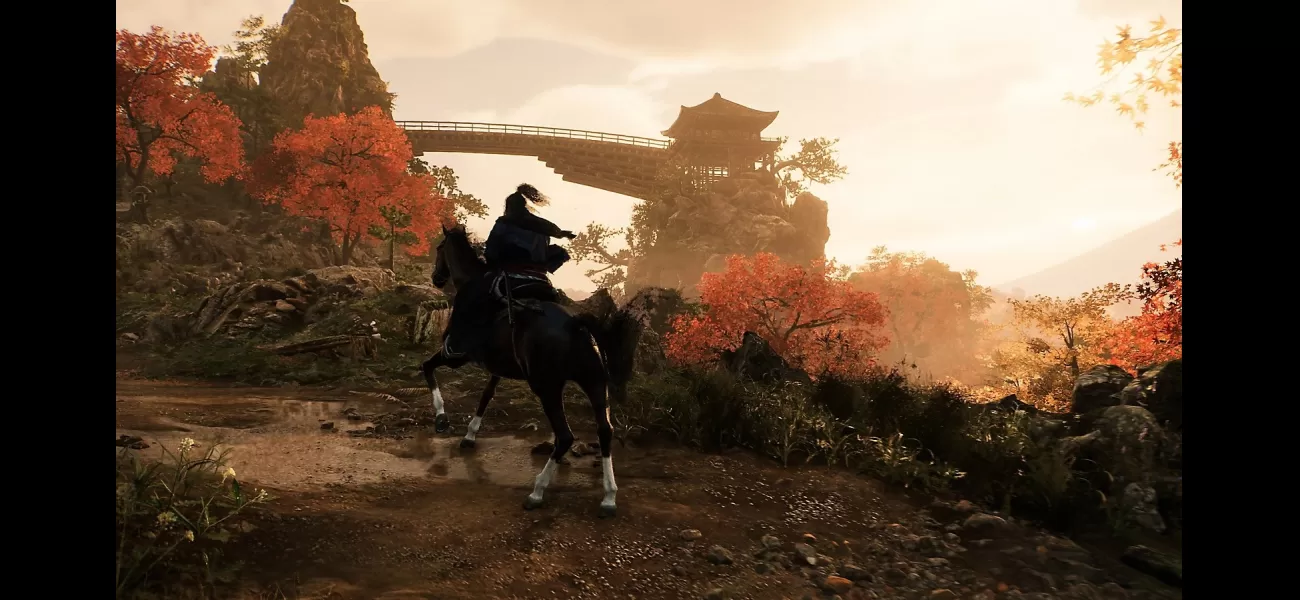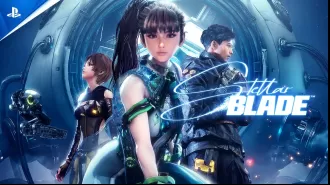A review of the game Rise of the Rōnin, compared to the popular game Ghost of Nioh.
New samurai game for PS5 from Nioh creators - how does it stack up against Ghost Of Tsushima?
March 21st 2024.

Rise of the Rōnin is the latest open world samurai game to hit the market and it has already garnered a lot of attention. But how does it compare to its predecessor, Ghost of Tsushima, which was released for the PS5? Although they both have a similar setting, the arrival of the hit TV series Shōgun has certainly helped to boost the popularity of Rise of the Rōnin. It is worth noting that while Ghost of Tsushima was praised for its authenticity, it was developed by an American company rather than a Japanese one.
While Ghost of Tsushima was a good game with accurate historical and cultural elements, it lacked the touch of a Japanese developer. As a country with limited cultural influence in live-action media, Japan holds a significant place in the world of video games. However, there are very few big-budget games with a realistic setting that are set in Japan. Rise of the Rōnin is a rare exception to this trend. Although its open world environment is heavily influenced by Western titles, the combat, mission design, and storytelling have a unique Japanese feel to them.
The game is set in the late 19th century, a decade before the events depicted in the movie The Last Samurai. The Western influence in Japan is on the rise and the game's first mission involves trying to assassinate the American naval commander in charge of ending Japan's economic and cultural isolationism. This is a significant deviation from the usual samurai media, but it is interesting to note that while the rural areas are still traditional, there are many Western-looking buildings in the game's version of Yokohama. Furthermore, guns are a common sight in the game, contrary to what was portrayed in The Last Samurai.
The plot of the game is based on historical facts, but it also incorporates elements of nationalism, colonialism, and technological advancement. However, the storytelling, like most Team Ninja games, lacks engagement and has a surprisingly frivolous tone at times. The player character belongs to a fictional anti-shogunate faction called the Veiled Edge, and interestingly, all the elite assassins in this faction are twins. As you progress through the game, you are presented with various story choices, including which side to support in the Boshin War. What's even more interesting is that you have the opportunity to go back and choose a different path if you regret your decision later on.
Loyalty is a key aspect of Rise of the Rōnin, and it works on multiple levels as you forge bonds with individuals, settlements, and various political organizations. Your choice of friends impacts the abilities and equipment available to you, which adds a unique twist to the game. Unlike other open world games, where all the content feels repetitive, Rise of the Rōnin offers a refreshing and interesting take on this aspect.
Being a big-budget triple-A Sony exclusive, Ghost of Tsushima's graphics and presentation were one of its main appeals. In comparison, Rise of the Rōnin falls short in this aspect, with its visuals looking more like a mid-budget last-gen game. However, the game makes up for it with its combat, which is more nuanced and heavily influenced by the combat systems in the Nioh series. This, in turn, was inspired by Dark Souls, and as a result, Rise of the Rōnin features bonfires that respawn enemies when used to replenish supplies. Additionally, when you die, you have to go back to the enemy that killed you to recover your belongings.
The combat in Rise of the Rōnin is not as difficult as Dark Souls or Sekiro, but it is not easy either, especially when it comes to the bosses. It involves more than just light and heavy attacks and relies heavily on the stamina meter, which recharges quickly. This adds a layer of strategy to the gameplay, as it encourages you to consider your actions carefully and not just rely on mashing the attack buttons. Similar to Sekiro, enemies in the game also use this system, and the key is to decrease their stamina to perform a devastating attack.
One of the game's unique features is the wide range of secondary weapons, including pistols, shurikens, bows, and rifles. You also have access to special martial skills, although they take some time to execute, they are nearly impossible to avoid. The combat options are further expanded by the ability to switch between two weapons and multiple stances with the press of a button. Each fighting style and weapon has its strengths and weaknesses, and your co-op companion can prove to be a valuable ally depending on their weapon of choice.
You can switch control to an AI ally at any time during the game, or you can call in up to two human players to assist you. While this was difficult to test before the game's launch, it is similar to the system used in Elden Ring, where you can summon help for specific missions rather than having players follow you around constantly.
The game also offers a variety of standalone missions that are more open-ended than simple boss fights. You can choose a ninja-esque character class at the beginning of the game or specialize as one as you progress. Stealth is a legitimate way to get past most obstacles, and you are equipped with a handy grappling hook right from the start, regardless of your class.
As you progress through the game, you acquire useful equipment, including a fictional hang-glider that makes traversal more enjoyable and less time-consuming. While Ghost of Tsushima followed a similar structure to old-school Assassin's Creed games, Rise of the Rōnin is more mission-based. This means that it has the open-world bloat of other Ubisoft games, with countless side quests and distractions. However, what adds to the frustration is the loot system, which gives you a new weapon, item, or piece of clothing after defeating an enemy. While this may seem good at first, it soon becomes a chore to sort through dozens of items for a trivial improvement in stats.
In conclusion, Rise of the Rōnin may have a unique setting, but it lacks originality in terms of gameplay. The combat is excellent, but it is not very different from the Nioh series. However, with its more grounded setting, it has the potential to reach a wider audience and achieve the success that Nioh did not.
The release of Rise Of The Rōnin marks another addition to the growing collection of open world games set in medieval Japan. However, this game, developed by the creators of Nioh, stands out from the rest with its unique take on samurai culture and gameplay mechanics. As the PS5's second open world samurai game, it's natural to compare it to the highly-praised Ghost Of Tsushima. But does it live up to the same standard?
While Ghost Of Tsushima is set in the 13th century, Rise Of The Rōnin takes place in the late 19th century, a decade before the events of the movie, The Last Samurai. This period of Japan is heavily influenced by Western culture, which is evident in the game's first mission where the player must attempt to assassinate an American naval commander. This setting not only adds a new layer of historical accuracy, but also provides a unique backdrop for the gameplay.
One of the most notable differences between Rise Of The Rōnin and Ghost Of Tsushima is the involvement of Japanese creators. While Ghost Of Tsushima was developed by an American company, Rise Of The Rōnin is created by Japanese developers. This adds a level of authenticity to the game, as seen in the attention to detail and respect for Japanese culture. However, the storytelling in Rise Of The Rōnin may not be as engaging as expected from a Japanese developer, with a more lighthearted tone at times.
The player takes on the role of a member of the Veiled Edge, a fictional anti-shogunate faction that relies on elite twin assassins. The game offers a variety of choices that affect the storyline, including which side to support in the Boshin War. One interesting feature is the ability to go back and change these decisions if desired. Loyalty is a key theme, as players must form alliances and make strategic choices to progress in the game.
In terms of graphics and presentation, Rise Of The Rōnin may not match the level of Ghost Of Tsushima, but it still offers a visually stunning Japanese landscape. Where it truly shines is in its combat, which is heavily influenced by the popular Nioh franchise. This means that combat is more nuanced and requires strategic thinking, similar to games like Dark Souls and Sekiro.
One unique aspect of Rise Of The Rōnin's combat is the use of Ki, which encourages players to think carefully and utilize defensive moves instead of just button-mashing. The game also allows players to switch between two weapons and multiple stances, adding another layer of strategy. The option to call in up to two other players for co-op missions is also available, adding an interesting dynamic to the gameplay.
While Rise Of The Rōnin offers a rich and detailed open world, it does suffer from some of the common pitfalls of the genre, such as side quests that can feel like unnecessary distractions. The loot system is also a bit overwhelming, with players constantly acquiring new weapons and items that can become tedious to sort through.
In the end, Rise Of The Rōnin may not be the most innovative game, but it offers a solid and enjoyable experience for fans of samurai culture and open world games. With its unique take on the setting and engaging combat, it's a promising addition to the growing collection of games set in medieval Japan.
While Ghost of Tsushima was a good game with accurate historical and cultural elements, it lacked the touch of a Japanese developer. As a country with limited cultural influence in live-action media, Japan holds a significant place in the world of video games. However, there are very few big-budget games with a realistic setting that are set in Japan. Rise of the Rōnin is a rare exception to this trend. Although its open world environment is heavily influenced by Western titles, the combat, mission design, and storytelling have a unique Japanese feel to them.
The game is set in the late 19th century, a decade before the events depicted in the movie The Last Samurai. The Western influence in Japan is on the rise and the game's first mission involves trying to assassinate the American naval commander in charge of ending Japan's economic and cultural isolationism. This is a significant deviation from the usual samurai media, but it is interesting to note that while the rural areas are still traditional, there are many Western-looking buildings in the game's version of Yokohama. Furthermore, guns are a common sight in the game, contrary to what was portrayed in The Last Samurai.
The plot of the game is based on historical facts, but it also incorporates elements of nationalism, colonialism, and technological advancement. However, the storytelling, like most Team Ninja games, lacks engagement and has a surprisingly frivolous tone at times. The player character belongs to a fictional anti-shogunate faction called the Veiled Edge, and interestingly, all the elite assassins in this faction are twins. As you progress through the game, you are presented with various story choices, including which side to support in the Boshin War. What's even more interesting is that you have the opportunity to go back and choose a different path if you regret your decision later on.
Loyalty is a key aspect of Rise of the Rōnin, and it works on multiple levels as you forge bonds with individuals, settlements, and various political organizations. Your choice of friends impacts the abilities and equipment available to you, which adds a unique twist to the game. Unlike other open world games, where all the content feels repetitive, Rise of the Rōnin offers a refreshing and interesting take on this aspect.
Being a big-budget triple-A Sony exclusive, Ghost of Tsushima's graphics and presentation were one of its main appeals. In comparison, Rise of the Rōnin falls short in this aspect, with its visuals looking more like a mid-budget last-gen game. However, the game makes up for it with its combat, which is more nuanced and heavily influenced by the combat systems in the Nioh series. This, in turn, was inspired by Dark Souls, and as a result, Rise of the Rōnin features bonfires that respawn enemies when used to replenish supplies. Additionally, when you die, you have to go back to the enemy that killed you to recover your belongings.
The combat in Rise of the Rōnin is not as difficult as Dark Souls or Sekiro, but it is not easy either, especially when it comes to the bosses. It involves more than just light and heavy attacks and relies heavily on the stamina meter, which recharges quickly. This adds a layer of strategy to the gameplay, as it encourages you to consider your actions carefully and not just rely on mashing the attack buttons. Similar to Sekiro, enemies in the game also use this system, and the key is to decrease their stamina to perform a devastating attack.
One of the game's unique features is the wide range of secondary weapons, including pistols, shurikens, bows, and rifles. You also have access to special martial skills, although they take some time to execute, they are nearly impossible to avoid. The combat options are further expanded by the ability to switch between two weapons and multiple stances with the press of a button. Each fighting style and weapon has its strengths and weaknesses, and your co-op companion can prove to be a valuable ally depending on their weapon of choice.
You can switch control to an AI ally at any time during the game, or you can call in up to two human players to assist you. While this was difficult to test before the game's launch, it is similar to the system used in Elden Ring, where you can summon help for specific missions rather than having players follow you around constantly.
The game also offers a variety of standalone missions that are more open-ended than simple boss fights. You can choose a ninja-esque character class at the beginning of the game or specialize as one as you progress. Stealth is a legitimate way to get past most obstacles, and you are equipped with a handy grappling hook right from the start, regardless of your class.
As you progress through the game, you acquire useful equipment, including a fictional hang-glider that makes traversal more enjoyable and less time-consuming. While Ghost of Tsushima followed a similar structure to old-school Assassin's Creed games, Rise of the Rōnin is more mission-based. This means that it has the open-world bloat of other Ubisoft games, with countless side quests and distractions. However, what adds to the frustration is the loot system, which gives you a new weapon, item, or piece of clothing after defeating an enemy. While this may seem good at first, it soon becomes a chore to sort through dozens of items for a trivial improvement in stats.
In conclusion, Rise of the Rōnin may have a unique setting, but it lacks originality in terms of gameplay. The combat is excellent, but it is not very different from the Nioh series. However, with its more grounded setting, it has the potential to reach a wider audience and achieve the success that Nioh did not.
The release of Rise Of The Rōnin marks another addition to the growing collection of open world games set in medieval Japan. However, this game, developed by the creators of Nioh, stands out from the rest with its unique take on samurai culture and gameplay mechanics. As the PS5's second open world samurai game, it's natural to compare it to the highly-praised Ghost Of Tsushima. But does it live up to the same standard?
While Ghost Of Tsushima is set in the 13th century, Rise Of The Rōnin takes place in the late 19th century, a decade before the events of the movie, The Last Samurai. This period of Japan is heavily influenced by Western culture, which is evident in the game's first mission where the player must attempt to assassinate an American naval commander. This setting not only adds a new layer of historical accuracy, but also provides a unique backdrop for the gameplay.
One of the most notable differences between Rise Of The Rōnin and Ghost Of Tsushima is the involvement of Japanese creators. While Ghost Of Tsushima was developed by an American company, Rise Of The Rōnin is created by Japanese developers. This adds a level of authenticity to the game, as seen in the attention to detail and respect for Japanese culture. However, the storytelling in Rise Of The Rōnin may not be as engaging as expected from a Japanese developer, with a more lighthearted tone at times.
The player takes on the role of a member of the Veiled Edge, a fictional anti-shogunate faction that relies on elite twin assassins. The game offers a variety of choices that affect the storyline, including which side to support in the Boshin War. One interesting feature is the ability to go back and change these decisions if desired. Loyalty is a key theme, as players must form alliances and make strategic choices to progress in the game.
In terms of graphics and presentation, Rise Of The Rōnin may not match the level of Ghost Of Tsushima, but it still offers a visually stunning Japanese landscape. Where it truly shines is in its combat, which is heavily influenced by the popular Nioh franchise. This means that combat is more nuanced and requires strategic thinking, similar to games like Dark Souls and Sekiro.
One unique aspect of Rise Of The Rōnin's combat is the use of Ki, which encourages players to think carefully and utilize defensive moves instead of just button-mashing. The game also allows players to switch between two weapons and multiple stances, adding another layer of strategy. The option to call in up to two other players for co-op missions is also available, adding an interesting dynamic to the gameplay.
While Rise Of The Rōnin offers a rich and detailed open world, it does suffer from some of the common pitfalls of the genre, such as side quests that can feel like unnecessary distractions. The loot system is also a bit overwhelming, with players constantly acquiring new weapons and items that can become tedious to sort through.
In the end, Rise Of The Rōnin may not be the most innovative game, but it offers a solid and enjoyable experience for fans of samurai culture and open world games. With its unique take on the setting and engaging combat, it's a promising addition to the growing collection of games set in medieval Japan.
[This article has been trending online recently and has been generated with AI. Your feed is customized.]
[Generative AI is experimental.]
0
0
Submit Comment





